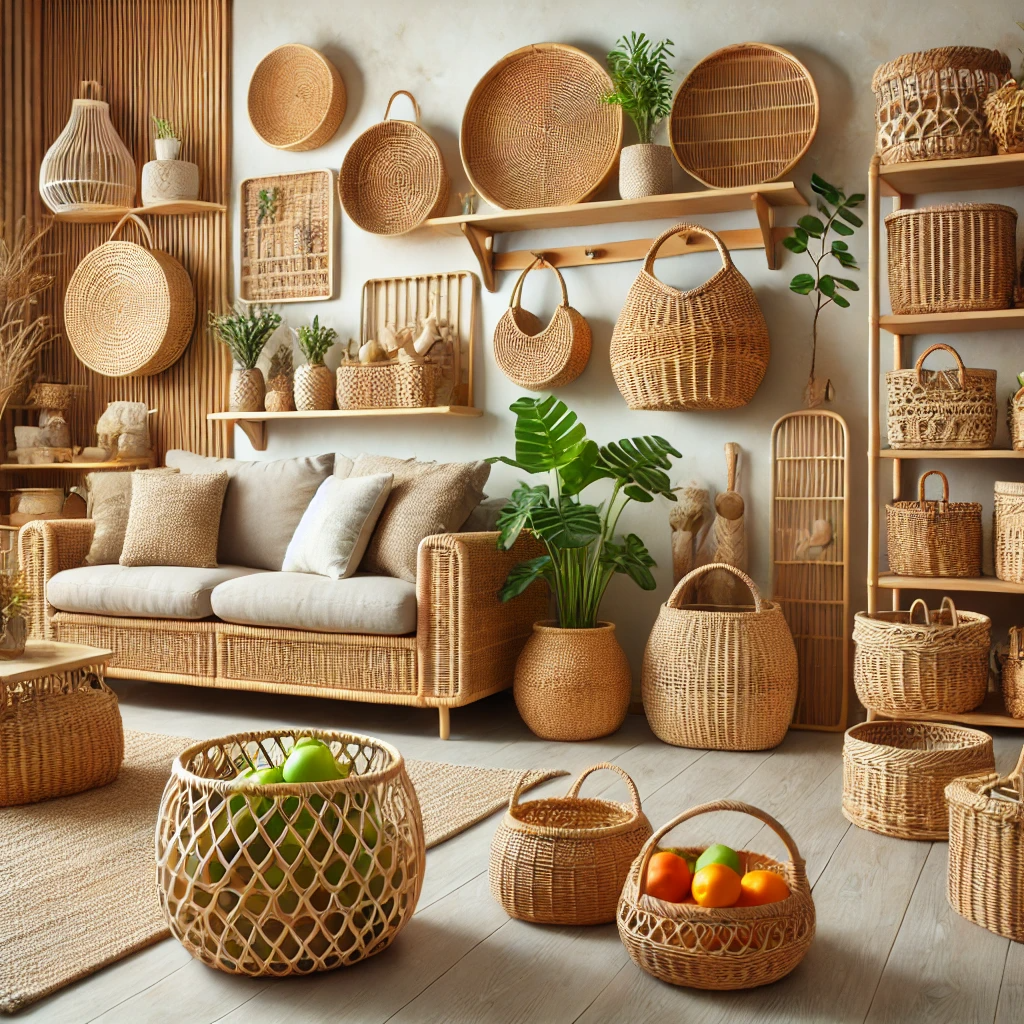News
Wicker and Rattan Crafts: Stylish and Eco-Friendly Baskets, Racks, and Storage
Introduction to Wicker and Rattan Craft
Wicker and rattan crafts have long been a favorite for those seeking a balance between style, function, and eco-friendliness. Both materials are versatile, sustainable, and have a unique aesthetic appeal, making them highly sought-after for crafting home décor and storage solutions. Wicker, a weaving technique rather than a material, is often applied to natural materials like rattan, which is a type of vine-like plant that grows in tropical regions. Due to their lightweight nature and flexibility, wicker and rattan products have been used for centuries to create baskets, racks, and storage items that are as functional as they are stylish.
Wicker and rattan items are not only known for their aesthetic qualities but also for their environmental benefits. Rattan, for instance, is harvested in a way that promotes forest preservation, as it grows rapidly and does not require cutting down trees. This makes rattan and wicker crafts an eco-friendly alternative to plastic or other synthetic materials commonly used in household products. In this article, we will explore the wide array of wicker and rattan products available for home décor and storage, their benefits, and how to care for them.
Wicker Baskets: A Stylish and Functional Choice
Wicker baskets are one of the most popular items made using the wicker weaving technique. They come in a wide variety of shapes and sizes, suitable for many different purposes around the home. Wicker baskets are both functional and aesthetically pleasing, often serving as storage solutions while also enhancing the overall décor of a space.
- Fruit Baskets
Wicker fruit baskets are a great addition to any kitchen or dining room. Their natural look complements the vibrant colors of fresh fruit, and the breathable nature of wicker allows air to circulate, helping to keep the fruit fresh for longer. Unlike plastic or metal fruit bowls, wicker baskets add warmth and texture to your kitchen décor, giving it a cozy, rustic feel. - Laundry Baskets
Wicker laundry baskets are another popular household item. They are sturdy enough to hold large loads of laundry, yet lightweight, making them easy to carry. In addition, their natural fibers allow for ventilation, preventing moisture buildup and helping to reduce odors in your laundry. Many wicker laundry baskets also come with removable fabric liners, making it easy to keep them clean and fresh. - Storage Baskets for Shelves and Cabinets
Smaller wicker baskets are perfect for organizing shelves and cabinets. They can hold anything from toiletries in the bathroom to toys in the living room. Wicker storage baskets add a touch of elegance and order to your home while hiding away clutter. These baskets are often used in open shelving to create a uniform, organized look. - Decorative Baskets
In addition to their practical uses, wicker baskets are often employed purely for decorative purposes. For example, a large wicker basket filled with rolled-up blankets can serve as both a storage solution and a cozy decorative element in a living room or bedroom. Smaller baskets can be used to hold candles, books, or even potted plants.
Wicker baskets come in a variety of styles, ranging from tightly woven, highly structured designs to looser, more rustic ones. They can be left in their natural color for a classic look or dyed in a variety of hues to match modern or bohemian interiors. Whether you need a functional storage solution or simply want to add a touch of nature to your décor, wicker baskets offer a versatile option for any room in the house.
Rattan Racks and Shelves for Home Organization
Rattan racks and shelves are increasingly popular in modern home décor, as they blend well with various interior styles, from coastal to minimalist to boho-chic. The lightweight yet durable nature of rattan makes it an ideal material for racks and shelves that can hold everyday items while adding a stylish touch to any room.
- Rattan Book Racks
Rattan book racks are a great addition to any living room or home office. Their open-weave design allows for airflow, making them ideal for storing books and magazines without collecting dust. Rattan’s natural color and texture bring a warm, earthy feel to any space, making it both functional and decorative. - Shoe Racks
Rattan shoe racks provide an elegant solution for organizing footwear. They are lightweight, easy to move around, and their natural appearance blends seamlessly into most home entrances or closets. Unlike metal or plastic shoe racks, rattan options provide a more natural look and feel, aligning with eco-conscious and stylish homes. - Wall-Mounted Shelves
Wall-mounted rattan shelves are perfect for smaller spaces or for adding storage without taking up floor space. These shelves can hold anything from books to small potted plants, and their natural texture brings warmth to a room. They are particularly well-suited for bathrooms, kitchens, or bedrooms, where you may want additional storage without overwhelming the space with bulky furniture. - Bathroom Racks
Rattan racks are also commonly used in bathrooms, where their natural resistance to moisture comes in handy. These racks can be used to store towels, toiletries, and even extra toilet paper in an organized yet stylish way. Their lightweight and open design make them perfect for small spaces, as they won’t overpower a room’s décor.
Rattan shelves and racks come in various sizes and designs, making it easy to find the right piece for any room in the house. From open shelving units to more intricate designs, rattan provides a versatile and stylish storage solution for modern homes.
Eco-Friendly Benefits of Choosing Wicker and Rattan Products
In addition to their aesthetic and functional appeal, wicker and rattan products have significant environmental benefits. As more people shift toward sustainable living, choosing eco-friendly materials like wicker and rattan becomes increasingly important. Here are some of the main eco-friendly benefits of these materials:
- Sustainable Harvesting
Rattan is a rapidly renewable resource that grows naturally in tropical rainforests. It grows quickly, sometimes as fast as 2-3 meters per year, and its harvesting does not require the destruction of trees or forests. This makes rattan a more sustainable option compared to hardwood, which takes decades to mature. In fact, the cultivation of rattan helps promote forest preservation, as it provides an economic incentive to protect natural habitats where rattan grows. - Biodegradability
Unlike plastic and synthetic materials, wicker and rattan products are biodegradable. When a wicker basket or rattan shelf reaches the end of its life, it can decompose naturally without leaving harmful waste behind. This is a significant advantage over products made from non-biodegradable materials, which contribute to pollution and environmental degradation. - Low Carbon Footprint
The production of wicker and rattan crafts typically involves minimal processing, which results in a lower carbon footprint compared to industrial manufacturing processes used for plastic or metal goods. Additionally, many wicker and rattan products are handcrafted by artisans, further reducing the environmental impact associated with large-scale manufacturing. - Supporting Local Artisans and Traditional Craftsmanship
By choosing wicker and rattan products, consumers often support local artisans in developing countries where these materials are sourced and crafted. Purchasing handmade wicker and rattan items helps preserve traditional craftsmanship and supports sustainable livelihoods in rural communities.
How to Care for Wicker and Rattan Products
While wicker and rattan products are durable, they require proper care to maintain their appearance and longevity. Below are some tips on how to care for wicker and rattan items:
- Cleaning
Regular dusting with a soft cloth or vacuuming with a brush attachment can help prevent dirt buildup on wicker and rattan surfaces. For deeper cleaning, use a damp cloth with a mild detergent, but be careful not to oversaturate the material, as excess moisture can weaken the fibers. - Avoiding Moisture
While rattan is somewhat moisture-resistant, prolonged exposure to humidity or water can cause damage. It’s best to keep wicker and rattan items away from direct contact with water and store them in well-ventilated, dry spaces. - Sun Protection
Overexposure to direct sunlight can cause wicker and rattan to fade and become brittle. To maintain their color and integrity, try to keep these items out of direct sunlight or use UV-protective coatings. - Repairing Damage
If your wicker or rattan product becomes damaged, minor repairs can be made by reweaving loose strands or reinforcing weak areas with wood glue. For more extensive repairs, consult a professional who specializes in wicker and rattan restoration.
Conclusion: Wicker and Rattan Crafts for the Eco-Conscious Homeowner
Wicker and rattan crafts offer the perfect blend of style, functionality, and eco-friendliness for the modern home. Whether you’re looking for stylish storage solutions, decorative baskets, or functional racks, these natural materials provide a timeless aesthetic that complements a wide variety of interior styles. Beyond their visual appeal, wicker and rattan products are an excellent choice for those seeking sustainable, environmentally friendly alternatives to plastic and synthetic materials. By choosing wicker and rattan, you’re not only enhancing your home’s décor but also supporting sustainable practices and local craftsmanship.

